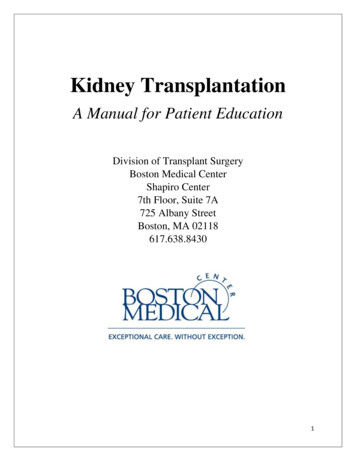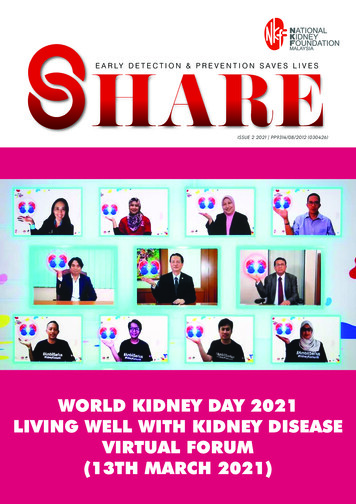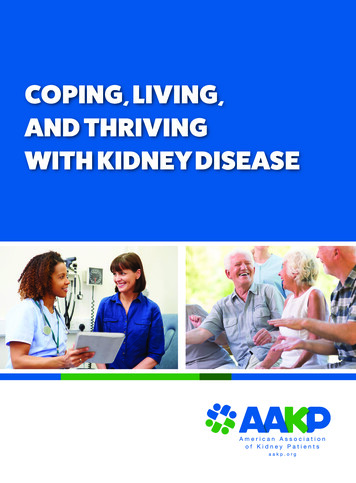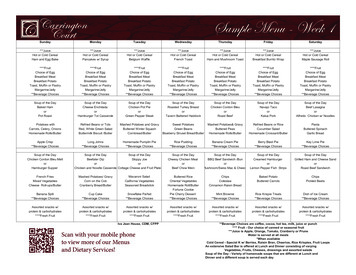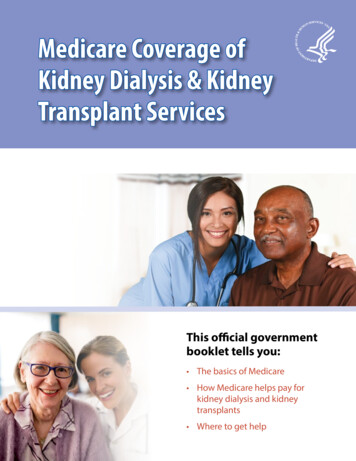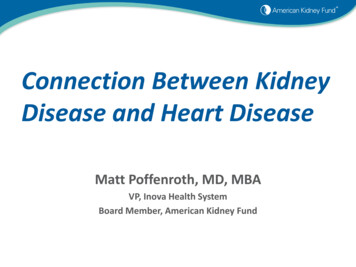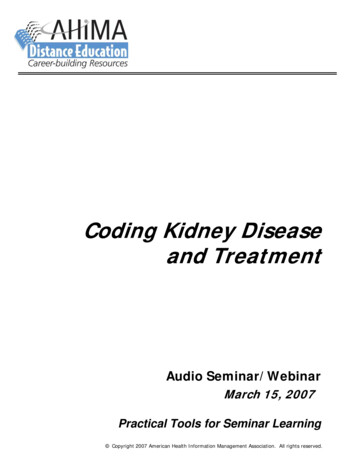
Transcription
Kidney Care Choices (KCC) ModelCMS Kidney Care First (KCF) Model IntroductionCMS/CMMINovember 2019
Kidney Care Choices (KCC) Model Builds onComprehensive ESRD Care (CEC) ModelComprehensive ESRD Care (CEC) Model Kidney Care Choices (KCC) ModelCEC Model began in October 2015 and willrun through December 31, 2020. Accountable Care Organizations (ACOs)formed by dialysis facilities, nephrologists, andother Medicare providers and suppliers worktogether with the goal to improve outcomesand reduce per capita expenditures for alignedESRD beneficiaries.KCF, along with KCC, will begin in 2020and will run through 2023 with the optionfor CMMI to extend the Models for one ortwo additional years. Single set of providers and suppliersresponsible for patient’s care from CKDStages 4,5 through dialysis,transplantation, or end of life care.Results for the Model showed lower spendingrelative to benchmark group andimprovements on some utilization and qualitymeasures.2
KCF Model Will Improve on CECGoals of KCF: Later and better starts on dialysis for beneficiaries with CKD. Better coordination of care for beneficiaries with CKD and ESRD to reduce total cost of care. More beneficiaries receiving kidney transplants and staying off of dialysis for longer. Offering different financial risk options for nephrologists and other providers and suppliers to take onfinancial accountability.KCF will include: Beneficiaries across the full spectrum of kidney disease including CKD Stages 4, 5 and ESRD as well asbeneficiaries who receive kidney transplants. Nephrologist payment reforms. Additional Medicare benefit enhancements.3
Overview of the Kidney Care Choices (KCC) ModelsFocusForTodayPayment OptionsOverviewParticipantsKidney Care First(KCF) ModelBased on the Primary Care First (PCF) Model – nephrology practices willbe eligible to receive bonus payments for effective management ofbeneficiariesNephrologists/nephrologypractices onlyCKCC GraduatedOptionBased on existing CEC Model One-Sided Risk Track – allowing certainparticipants to begin under a lower-reward one-sided model andincrementally phase in risk and additional potential rewardCKCC ProfessionalModelBased on the Professional Population-Based Payment option of the DirectContracting Model – with 50% of shared savings or shared losses in thetotal cost of care for Part A and B servicesCKCC Global ModelBased on the Global Population-Based Payment option of the DirectContracting Model – with risk for 100% of the total cost of care for all PartA and B services for aligned beneficiaries4Must include nephrologistsand nephrology practices;may also include transplantproviders, dialysis facilities,and other kidney careproviders on an optionalbasis
KCC Model Timeline and Next Steps The Model will run from approximately March 1, 2020 through December 31, 2023, withthe option for CMS to extend the Model for one or two additional years. Selected providers and suppliers will begin Model participation in 2020 with a focuson building necessary care relationships and infrastructure. Payment adjustments will begin in 2021. CMS released the Request for Application in October 2019 and applications are dueJanuary 22, 2020.More information will be available at the KCC Model website. Signup via email and follow CMS on Twitter (@CMSinnovates).5
Alignment and OperationsCMS/CMMI
Beneficiary Alignment BasicsAlignment for CKD Stage 4 & 5 and ESRD Beneficiaries Beneficiaries are aligned to a KCF Practice based on qualifying visits with a KCF nephrologist. Prioritizes the nephrologist relationship for beneficiaries with advanced CKD or ESRD. Protects continuity of care from treating a beneficiary with CKD 4 or 5 with the same nephrologistwho would then be treating them if progression to ESRD occurs. Alignment will be based on beneficiary claims. Minimum Number of Visits:CKD Stage 4 & 5 BeneficiariesESRD Beneficiaries2 or more qualifying Evaluation &Management (E&M) visits within a 6month period with a KCF nephrologist2 or more qualifying Monthly CapitationPayment (MCP) visits within a 3-monthperiod with a KCF nephrologist7
Beneficiary Alignment BasicsAlignment for Transplant Beneficiaries Transplant beneficiaries must first be aligned to the KCF practice as a CKD or ESRD beneficiary When an aligned beneficiary receives a kidney transplant, they will remain aligned to the KCFPractice for 3 years from the month of transplant, while the transplant is viable If the transplant fails, the beneficiary may become realigned as a CKD or ESRD beneficiary, solong as they continue to meet alignment criteria8
Beneficiary Eligibility CriteriaTo be eligible for alignment and remain aligned for a performance year, all beneficiaries must: Have late stage CKD (stage 4 or 5), ESRDor be a transplant recipient previouslyaligned Have a plurality of their CKD care in the KCFpractice’s market (CKD beneficiaries only) Be enrolled in Medicare A and B and NOT ina Medicare Advantage plan, cost plan, orother Medicare managed care plan NOT have already been aligned to aMedicare program/demonstration/modelinvolving shared savings at the date ofalignment NOT have Acute Kidney Injury (AKI) Reside in the United States Must NOT have Medicare as a secondarypayer. Have a majority of their Monthly CapitationPayments (MCP) billed in the geographicarea (ESRD beneficiaries) Be aged 18 and above and NOT deceased9
Beneficiary Alignment Timeline KCF Practices will receive a list at the start of the year with the beneficiaries whosecare they will be accountable for based on visits in the past year. Newly eligible beneficiaries will then be added to a KCF Practice’s alignment listquarterly. Beneficiary eligibility will be considered on a monthly basis, but will be updatedquarterly with the updated alignment list. Alignment will be as prospective as is feasible, but a final retrospective reconciliationwill occur after each performance year. Beneficiaries will be removed on an annual basis during reconciliation for eligibilitypurposes, such as not receiving care from an KCF nephrologist, or receiving themajority of care outside of the market area.10
Minimum Number of Aligned BeneficiariesA KCF Practice must have a minimum of 500 beneficiarieswith late stage CKD and 200 beneficiaries with ESRDaligned throughout the life of the Model, based on a definedlook-back period prior to the start of the performance year.Practices or nephrologists are required to aggregate theirperformance if they do not meet minimum beneficiarycounts.11
Minimum Number of Aligned BeneficiariesBeneficiaries with CKDBeneficiaries with ESRDNephrologistNephrologistAligning Participant2 Evaluation &Management (E&M) visitswithin a 6-month periodCriteria for Alignmentwith a KCF nephrologistwith a diagnosis of CKD 4or 5Receiving the majority ofE&M visits for kidney careCriteria for De-Alignment outside the KCF practice’smarket2 MCP visits within a 3month period with a KCFnephrologistReceiving the majority ofMCP visits from a nonKCF nephrologist12Beneficiaries whoReceive KidneyTransplantsN/A – Must have beenpreviously aligned byvirtue of CKD or ESRDBeing previously firstaligned to the KCFpractice as a CKD orESRD beneficiary andreceiving a kidneytransplantKidney transplant failure(likely the beneficiary thenaligns as a CKD or ESRDbeneficiary)
Financial Methodology and StructureCMS/CMMI
Legal Structure of the KCF ModelLegal Entity & ContractingRequirements1. Must be able to receive the paymentsunder the model from CMS.CMS Kidney Care First (KCF) Practice2. Must demonstrate the ability toassume financial risk and make anyrequired repayments to the Medicareprogram.NephrologistsNephrology Practices143. Must establish reporting mechanismsand ensuring compliance withprogram requirements, including butnot limited to, reporting on qualitymeasures.
KCF Practice Eligibility CriteriaNephrologists and nephrology practices participating in the KCF model must meet all of thefollowing requirements for the duration of their participation in the model. In particular, theymust: Be enrolled in Medicare. Self-identify as nephrologists for the purposes of this model (Nephrologists should verify that their specialty iscorrect in PECOS). Provide services to a minimum of 500 late stage CKD and 200 ESRD aligned Medicare beneficiaries over thecourse of 6 months. There is no minimum number of transplant beneficiaries required. Receive at least 50% of their Medicare payments for services furnished to beneficiaries with CKD, ESRD, or afunctioning transplant. Use the 2015 Edition Certified Electronic Health Record Technology (CEHRT), support data exchange withother providers and health systems via Application Programming Interface (API), and connect to their regionalhealth information exchange (HIE). Demonstrate the ability to assume financial risk and repay any required monies to the Medicare program. Be located entirely in a single KCF market area.15
KCF Nephrologist CriteriaNephrologists and nephrology practices participating in the KCF model must meet all of thefollowing requirements for the duration of their participation in the model. In particular, theymust: Be enrolled in Medicare. Self-identify as nephrologists for the purposes of this Model. CMS will verify this informationagainst PECOS, or through other means, including claims data.16
Key Reimbursement Mechanisms1.Adjusted Monthly Capitated Payment (AMCP): Capitated payment paid to modelparticipants to managed ESRD, based on the MCP2.CKD Quarterly Capitated Payment (CKD QCP): Capitated payment paid to modelparticipants to manage CKD 4 / 5 patients3.Kidney Transplant Bonus (KTB): Incremental reimbursement for successful kidneytransplant4.Performance Based Adjustment (PBA): Upward or downward adjustment to the CKDQCP and AMCP based on participant’s year-over-year continuous improvement andperformance relative to peers (available to KCF practices only)17
Adjusted Monthly Capitated Payment (AMCP)Monthly CapitatedPayment (MCP)AMCPStatus QuoCapitated rate varies depending ondialysis location and volume ofmonthly nephrologist visits 4 Monthly nephrologist visits &in center dialysis 2 – 3 monthly nephrologistvisits & in center dialysis Home dialysis 1 monthly nephrologist visit & inhome dialysisFlat rate independent of nephrologistvisits or dialysis locationCapitated rate set at the MCP’s 2-3monthly nephrologist visit rate18
CKD Quarterly Capitated Payment (CKD QCP) The CKD QCP are capitated payment paid to model participants to manage CKD 4 and5 patients. This will not impact billing, but it will impact payment for the following services:Services Included in QCPCPT CodesOffice / Outpatient Visit E&M99201-99205, 99211-99215Prolonged E&M99354-99355Transitional Care Management Services99495-99496Advance Care Planning99497-99498Welcome to Medicare and Annual Wellness VisitsChronic Care Management ServicesG0402, G0438, G04399949019
CKD Quarterly Capitated Payment (CKD QCP)Rates:The CKD QCP will be set to one third of the AMCP rate, paid quarterly for alignedbeneficiaries with CKD stage 4 or 5, replacing the amount that nephrologists would havereceived for billing those codes. For example, If a participant receives AMCP of 180 permonth, then the participant’s CKD QCP will be 180 per quarterLeakage:The CKD QCP will be adjusted to account for “leakage rates” that will apply an individualleakage rate for each practice, based on the aggregate CKD nephrology services (i.e.,primary care E/M services) furnished outside of the practice for the practice’s aligned CKDbeneficiaries.20
Kidney Transplant Bonus (KTB)Bonus payment of 15,000 per aligned beneficiary who receives a kidney transplant andremains alive with a functioning transplant.TransplantReceivedTiming of KTBpaymentsTransplant 1YearTransplant 2YearsProviderreceives 2500Transplant 4YearsTransplant 3YearsProviderreceives 5000Providerreceives 7500KTB paid over the next 3 years following the transplant, provided the transplant remainssuccessful21
Performance and QualityCMS/CMMI
KCF Quality OverviewThe KCF Model accounts for quality in two ways: the Quality Gateway and the PerformanceBased Adjustment (PBA). The Quality Gateway is a quality threshold based on a set of measures that: Indicate appropriate clinical care and engagement for the patient population; Are related to the beneficiary’s kidney disease; and Are applicable to both CKD stage 4 and 5 ESRD beneficiaries. Performance Based Adjustment (PBA) are based on a calculation including both relativeperformance and continuous improvement on a set of cost and utilization metrics.23
Steps To Calculate the Performance BasedAdjustment (PBA) Step 1: Assign each KCF practice to a Group depending its performance on the PBA utilization measuresrelative to other KCF practices to determine the size of the Relative Performance Component of the PBA. KCFPractices that fail Quality Gateway automatically fall into Group 8, which has the maximum downwardadjustment. Step 2: Determine eligibility for the Continuous Improvement (CI) component of the PBA. CI is the year-overyear % improvement that the KCF practice needs to achieve to be eligible for the bonus. In order to be eligiblefor the Continuous Improvement Component, a KCF practice must achieve the Quality Gateway. Step 3: Determine the size of the KCF Practice’s Continuous Improvement Component of the PBA24
KCF Quality Gateway The Quality Gatewaymeasures will reflectappropriate clinical careand patient experience forthe affected population.PBA Performance LevelTop 50 Percent of Performers – Compared to All KCF PracticesGroup 1 – Top 10% of KCF Practices% Adjustmentto CKD QCPand AMCP 20%Group 2 – 11 – 20% of KCF Practices 16%Group 3 – 21% – 30% of KCF Practices 12%Group 4 – 31% – 40% of KCF Practices 8%Group 5– 41% – 50% of KCF Practices 2%Bottom 50 Percent of Performers – Compared to All KCF Practices Practices who do notmeet the threshold willreceive the maximumnegative paymentadjustment.Group 6 – Bottom 50% of KCF practices and the top 50% ofnephrology practices nationallyGroup 7 – Bottom 50% of KCF practices and 51% – 75% (25th to 50thpercentile) of nephrology practices nationallyGroup 8 – Bottom 50% of KCF practices, below the 25th percentile ofnephrology practices nationally OR did not pass Quality Gateway250%-6%-20%*
Summary Table of PBA CalculationPutting the Components TogetherPBA Performance LevelGroup 1Group 2Group 3Group 4Group 5Group 6Group 7Group 8Cleared Quality GatewayFailed to Clear QualityGatewayPBA Components (Percent Adjustment toCKD QCP & AMCP)Relative PerformanceContinuousRP ComponentImprovement CIComponentTotal PBA Impact (% Adjustment to CKD QCPand AMCP)RP CIRP Only(Maximum Upward PBA (Does not qualify forAdjustment )CI) 20% 16% 12% 8% 2%0%-6% 10% 8% 6% 4% 4% 4% 4% 30% 24% 18% 12% 6% 4%-2% 20% 16% 12% 8% 2%0%-6%-20% 10%-10%-20%-20%0%-20%-20%26
PBA Calculation TimelinePBA Performance, Calculation, and Payment Adjustment PeriodPBA PerformancePeriodPY1 - Q1 and Q2(for RP only)PY1 - Q3 and Q4(for RP only)PY2 - Q1 and Q2(for RP and CI)PY2 - Q3 and PY2Q4 (for RP and CI)PY3 – Q1 and Q2(for RP and CI)PY3 – Q3 and Q4(for RP and Q4PY stPaymentMeasureCalculateQ1-Q2*Data collection on measure performance concludes at end of PBA performance periodCalculation PeriodPBA amount calculated during PBA calculation period based on performance during PBA performance periodAdjustment PeriodPerformance-based adjustment applied to CKD QCP and AMCP during the PBA payment adjustment period*Calculation and application of the PBA during the 6-month periods following upon PY3.27Q3-Q4*AdjustPayment
Benefit EnhancementsCMS/CMMI
Kidney Disease Education (KDE) BenefitEnhancementsMedicare currently covers up to six 1-hour sessions of KDE services for beneficiaries withStage IV CKD. KCF will be waiving certain KDE requirements, as education is a crucialcomponent to increasing rates of transplants, implementing successful home dialysis, anddelaying the onset of ESRD. The following requirements will be waived: Waives requirement that that KDE be performed by a physician, physician assistant, nursepractitioner, or clinical nurse specialist to allow qualified clinicians to bill for the benefit who are nototherwise allowed. Extends eligibility for KDE from just Stage IV CKD patients to beneficiaries with CKD Stage V andthose in the first 6 months of ESRD. Allows the topic of delaying initiation of dialysis to be covered “as applicable” rather thanmandated, as it will not be relevant to beneficiaries with ESRD. Allow the required outcomes assessment be conducted during a subsequent evaluation andmanagement visit with the nephrologist instead of within one of the six KDE sessions.29
Other Benefit Enhancements for KCFTelehealth Waives requirementthat beneficiaries belocated in rural areafor telemedicine to befurnished Assists beneficiariesdialyzing at home,potentially loweringrisk for infection forimmunocompromisedpersons and olderadultsPost-DischargeHome Visit Allows auxiliarypersonnel to furnishin-home servicesafter a discharge froma hospital under thegeneral supervision(rather than directsupervision) of thephysician or nonphysician practitioner30Home Health Waives the “confinedto his home”requirement forutilizing home healthservices
For More Information on KCF Sign up for our KCC listserv Visit the website at -choices-kcc-model Apply at the RFA Online portal at https://app1.innovation.cms.gov/KCC/ Follow us on Twitter at @CMSinnovates For any questions, please email the KCC Model team at KCF-CKCC-CMMI@cms.hhs.gov31
Kidney Care Choices (KCC) Model KCF, along with KCC, will begin in 2020 and will run through 2023 with the option for CMMI to extend the Models for one or two additional years. Single set of providers and suppliers responsible for patient's care from CKD Stages 4,5 through dialysis, transplantation, or end of life care.
